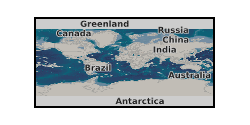University of Sheffield
Type of resources
Topics
Keywords
Contact for the resource
Provided by
Years
Formats
Representation types
Update frequencies
Resolution
-

This presentation on the UKCCSRC Call 1 project, UK Bio-CCS CAP, was presented at the Cardiff Biannual, 10.09.14. Grant number: UKCCSRC-C1-38.
-

This presentation on the UKCCSRC Call 1 project, UK Bio-CCS CAP, was presented at the Cranfield Biannual, 22.04.15. Grant number: UKCCSRC-C1-38.
-

This poster on the UKCCSRC Call 1 project Bio-CAP-UK: Air/oxy biomass combustion with CO2 capture technology was presented at the CSLF Call project poster reception, London, 27.06.16. Grant number: UKCCSRC-C1-38. Bio-CCS - bioenergy with carbon capture and storage - has the ability to achieve potential net negative CO2 emissions, vital for meeting legally binding and increasingly stringent emission targets and carbon budgets. Bio-CCS has a large and distinct potential for significantly lowering CO2 emissions from energy production; thus the key messages from this programme will have clear policy implications on decarbonisation strategies. The Bio-CAP-UK project aims to accelerate progress towards achieving operational excellence for flexible, efficient and environmentally sustainable bio-CCS thermal power plants by developing and assessing fundamental knowledge. This is being achieved through extensive multi-scale experimental work, including bench and pilot-plant tests, combined with system simulations, techno-economic analysis and life cycle studies. The programme focuses on comparing air-firing coupled with post-combustion carbon capture to oxy-fuel combustion.
-

This presentation on the UKCCSRC Call 1 project, UK Bio-CCS CAP, was presented at the Cranfield Biannual, 22.04.15. Grant number: UKCCSRC-C1-38. Video available at https://vimeo.com/111747716.
-

This poster on the UKCCSRC Call 1 project, UK Bio-CCS CAP, was presented at the Cranfield Biannual, 22.04.15. Grant number: UKCCSRC-C1-38.
-

This presentation on the UKCCSRC Call 1 project, UK Bio-CCS CAP, was presented at the Cranfield Biannual, 22.04.15. Grant number: UKCCSRC-C1-38.
-

To accelerate progress towards achieving operational excellence for flexible, efficient and environmentally sustainable Bio-CCS thermal power plants by developing and assessing fundamental knowledge, pilot plant tests and techno economic and life cycle studies. In terms of assessing CO2 capture, the UK CCS on-going research portfolio includes coal and gas-fired generation, whilst limited work is being conducted on the assessment of dedicated biomass to power with CCS, or indeed, of co-firing fossil fuel generation with higher rates of biomass with CCS. The project will also greatly expand the on-going research in SuperGen Bioenergy concerning supply chains of torrefied biomass and Bio-CCS. Grant number: UKCCSRC-C1-38.
-
This dataset contains sequential biomass harvests from a plant growth experiment carried out under controlled environmental conditions in Sheffield. The experiment was carried out in three parts in 2016 and 2017, and was designed to investigate differences in growth among grasses with the C3 and C4 photosynthetic pathways, and with annual and perennial life histories. Plants were harvested approximately weekly over a period of five weeks. The data include information on the dry biomass of roots and leaves, and the numbers of roots, leaves and shoot branches. Also included is an independent dataset of leaf anatomical characteristics derived from herbarium specimens, which was used to test how mechanical support scales with leaf size. Finally, the data include the phylogenetic relationships among species, which were used in analyses. The work was funded by NERC standard grant NE/N003152/1. Full details about this nonGeographicDataset can be found at https://doi.org/10.5285/cb0d7a37-45c5-4645-b5ef-ba097d92fc20
-
Data comprises of the uptake of the plant nutrient phosphorus (P) by seven common and often co-occurring herbaceous plants grown in limestone grassland soil in pots. P uptake is from one of three different sources of P that were injected into the soil, with the P sources being labelled with radio-isotope 33P, such that uptake of this could be quantified by assessing the radioactivity of the plant tissue. The plant species were grown in pots as monocultures, and as mixed communities containing all seven species. The 33P labelled P sources that were injected into the soil were orthophosphate, DNA and calcium phosphate. Assessment of the amount of 33P taken up was undertaken by harvesting and analysing plant shoots six days after the 33P source was injected into the soil. The datasets contain biomass of the harvested plant material, its radioactivity as assessed by scintillation counting, and the calculated proportion of the 33P supplied that was taken up into plant shoots. The data also contains % cover abundance values of the plant species from surveys undertaken at Wardlow Hay Cop, the limestone grassland from where the soil was sourced on which the plants were grown for the 33P addition study. Full details about this dataset can be found at https://doi.org/10.5285/87cdc267-a8c7-4f59-83b4-1bceaae837ad
-

In this submission we Include three data sets collected as part of a NERC Urgency programme. Data were collected from a key field site within the Marlborough Fault Zone (MFZ), New Zealand. The Mw 7.8 Kaikoura Earthquake of 14th November 2016 was characterised by a surprising degree of spatial complexity in the surface displacement field in the Marlborough region, South Island, New Zealand. This complexity includes movement on up to 12 faults, besides a high degree of variability in apparent slip along strike of individual faults over relatively short distances. The Urgency programme included rapid collection of Terrestrial Laser Scanning (TLS), Structure from Motion (SfM) and Global Navigation Satellite System (GNSS) data immediately after this event. We include data for one of our field sites for which data collection succeeded, and processing has been completed. For a summary of the key initial findings from this data set, see the following EGU 2018 Abstract and summary: https://meetingorganizer.copernicus.org/EGU2018/EGU2018-6847.pdf
 NERC Data Catalogue Service
NERC Data Catalogue Service